Zucchini and summer squashes are rewarding to grow because they produce many pounds of fruit per plant. They are sun-loving plants that are easy to grow and require less space than their winter cousins. We will review all the details on how to grow them in this guide.
About Summer Squash
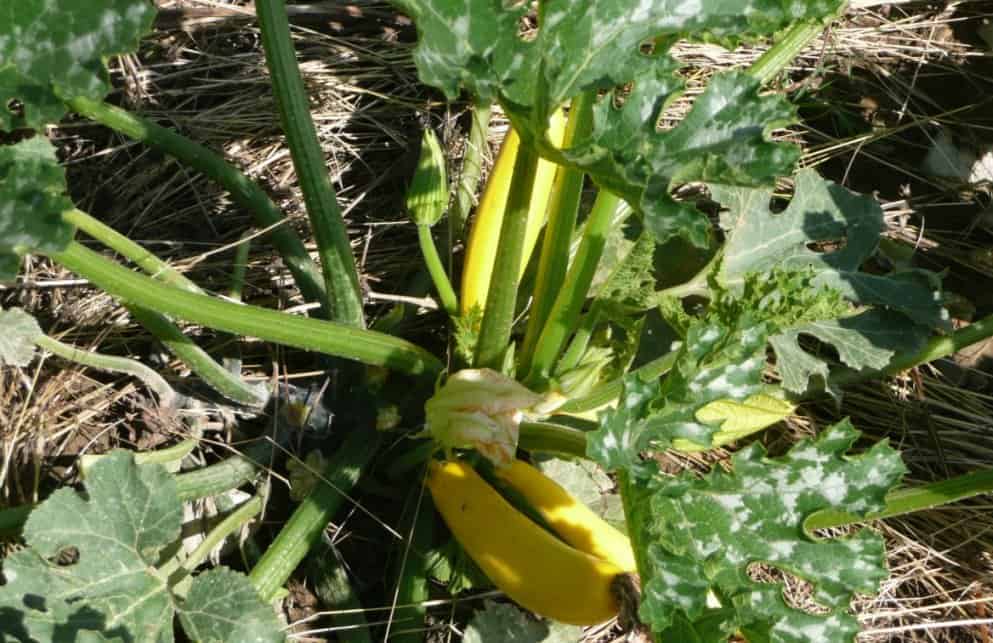
Most summer squashes are bush varieties that require less space than vining winter squashes, such as acorn and butternut squash.
© – License
Summer squash is a great vegetable to grow in the summer months. It includes varieties like zucchini, yellow squash, pattypan, and crookneck. Summer squash has edible skin that is much thinner than winter squash, making it easy to cook with or eat raw. Additionally, most summer squashes are bush varieties that require less space than vining winter squashes, such as acorn and butternut squash. Bush varieties of summer squash can be grown in containers, small spaces, and larger garden beds. When choosing your summer squash variety, there is something for everyone!
All types of summer squash require similar care. So, even though this guide mainly focuses on growing zucchini, the same tips can be applied to any type of summer squash. Zucchinis are very vigorous growers; one or two plants will usually produce an abundant crop that may even leave you with too much! If you find yourself inundated with zucchini during peak season, it’s a great idea to share them with your neighbors or make some delicious zucchini cakes!
Where to Plant
When considering a location for your squash or zucchini plants, make sure it is in an area that gets full sun exposure. Additionally, you’ll want to choose a spot that offers some shelter from windy conditions. This will help with pollination and ensure optimal growth.
The soil should be moist but not waterlogged and free-draining – all of these factors are essential for growing healthy and productive plants. It’s also beneficial to mix compost or manure into the soil before planting – this will provide added nutrients that can support overall plant health throughout the season. The ideal soil pH for summer squashes is 6.0 to 6.5.
When to Plant
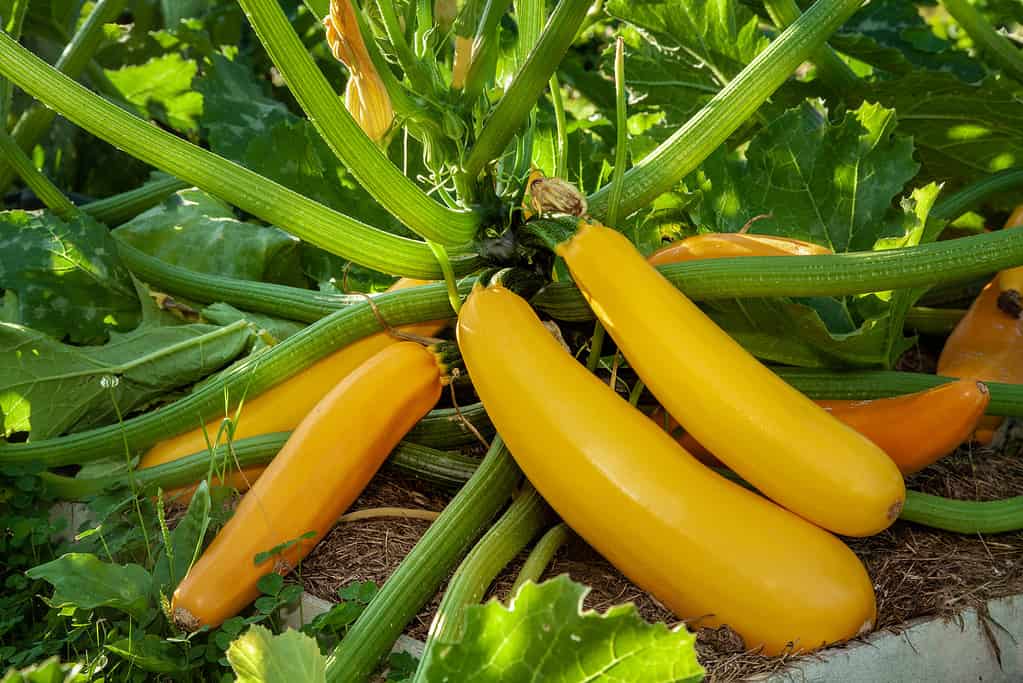
It is also wise to plant a few squash plants in July, as these late plants arrive when the danger of squash vine borers is passed.
©Zhukovskaya Elena/Shutterstock.com
When direct-sowing summer squash and zucchini seeds, ensure all danger of frost has passed and the soil temperature is at least 60ºF. Check your local weather forecast for a prediction of your last frost date.
If you wish to start them indoors, sow the seeds in decomposable pots 2 to 4 weeks before your last spring frost. Be aware that squash seedlings can be delicate when transplanting, so it is best to plant the entire pot in the ground with the plant.
Once the soil has been prepared in early spring, warm it up more quickly with black plastic. It is also wise to plant a few squash plants in July, as these late plants arrive when the danger of squash vine borers is passed.
How to Plant
When direct sowing, ensure that the seeds are planted at least 1 inch deep in level ground and spaced 3 inches apart. Alternatively, you can sow three seeds close together on a small hill of soil. Whether rows or mounds, space them six feet apart.
In cold climates where temperatures may still be low during springtime, additional protection may be needed. Use any cover you have available to keep your seeds and seedlings warm, as they cannot handle the slightest frost.
After planting, thoroughly water the area before adding a layer of mulch, such as bark, straw, or garden compost, to help lock in soil moisture and prevent drying out over time.
How to Grow
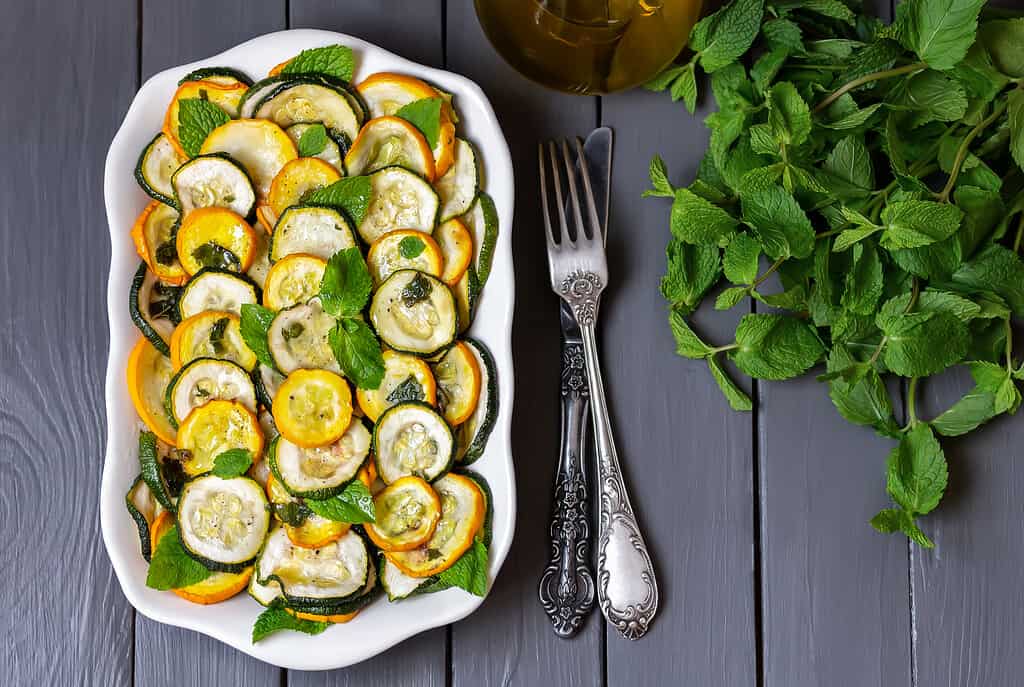
If properly stored, zucchini will stay fresh for up to 10 days without spoiling.
©Dementieva Iryna/Shutterstock.com
Mulching is an important step in successfully growing summer squash and zucchini. Not only will it help to discourage weeds, but mulch also helps to retain moisture and protect the shallow roots of these plants. Zucchini are particularly fond of moist soil, so water thoroughly, frequently, and consistently for best results. Aim for about 1 inch per week when watering your plants. Be sure to pay special attention when fruits start forming. With long soakings, you’ll need to keep the soil adequately moist throughout its growth cycle. It’s worth noting that inadequate water or fertilization can lead to misshapen or split squash, so ensure you’re providing proper care!
Once your summer squash and zucchini plants have sprouted, keep weeds at bay. Carefully remove any weeds that may have managed to break through the soil. To help keep the area around your plants neat and tidy, cut off any dead or shriveling weeds as you see them. When blooms begin to appear on your squash and zucchini plants, sprinkle the soil with a balanced fertilizer.
A lack of pollination by bees can cause squash flowers not to bear fruit or to yield small fruit. Squash plants produce male and female flowers, with the males appearing first on thin stalks. To successfully pollinate the female flowers and produce fruit, bees must transfer pollen from the male flowers – or the gardener can do so manually with a cotton swab. To encourage bee pollination, add plants that attract bees in the vicinity of the squash.
When to Harvest
When harvesting summer squash, pick the vegetables when they are still tender and immature and under eight inches long. Overly large squash can be quite tasteless.
Most varieties of summer squash take an average of 60 days to reach maturity after flowering. To ensure you’re picking at the right time, check the seed packet for more exact information on when your particular variety will be ready.
It’s essential not to wait too late in harvesting as this can cause the vegetables to become overly large and tough with little flavor. Continually picking fruit lets the plant put more energy into producing more fruit for a very large yield.
How to Harvest
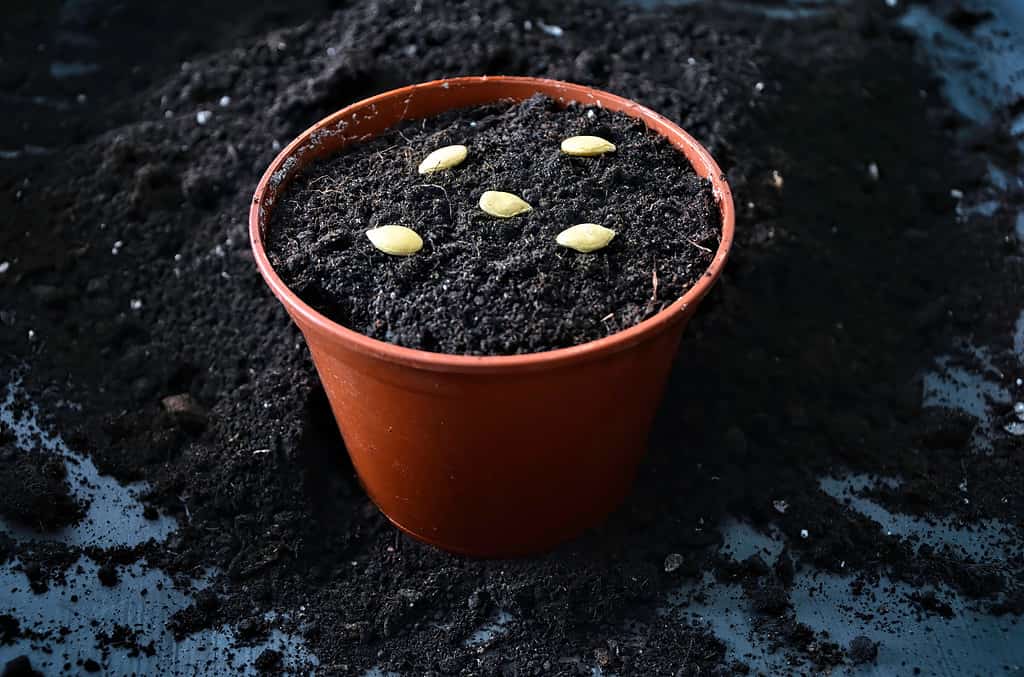
After planting, thoroughly water the area before adding a layer of mulch, such as bark, straw, or garden compost, to help lock in soil moisture and prevent drying out over time.
©Jullex51/Shutterstock.com
Cut the fruit from the vine with a sterilized knife. Do not tear it off, or you risk damaging the stem of the plant. For best results, ensure that at least 1 inch of the stem is left on each fruit when harvesting.
You may wish to slow down the production when you have had your fill of squash. To do this, harvest smaller fruits earlier and remove male flowers as they appear to prevent pollination. If you plan to be away, make sure to remove the larger squash upon your return.
Finally, reap the entire harvest before the first fall frost. Summer squash varieties are tender and will die in frosty conditions.
How to Store
It is important to store unwashed summer squash in a cool, dry place. Placing them in a plastic or paper bag with one end open will help increase air circulation and keep the vegetables from becoming soggy. To get the maximum shelf life out of these vegetables, store them in your refrigerator’s crisper drawer. Under optimal conditions, you can expect zucchini to keep for up to 10 days without spoiling. If stored correctly, they should remain firm and full of flavor throughout this time period.
To freeze zucchini, choose young squash that is smaller than six inches long. Wash the squash and cut it into small rounds. Blanching the slices in boiling water for three minutes is important to help preserve their flavor, color, and texture during storage. To blanch them properly, drop the slices into boiling water for three minutes, then quickly transfer them to a bowl of ice-cold water. Leave them in the ice bath for another three minutes before draining and patting dry as needed. Pack into freezer-safe containers, leaving one inch of head space. If stored correctly, frozen zucchini will keep its freshness for up to three months!
Companion Plants
Several plants grow great in conjunction with summer squash, including beans, dill, garlic, marigolds, oregano, peas, and nasturtiums. Peas and rosemary are also good choices.
Avoid planting summer squash anywhere near potatoes or pumpkins. And then, of course, we have fennel, which doesn’t play well with anyone and should be planted alone.
What Are the Best Types of Summer Squash and Zucchini?
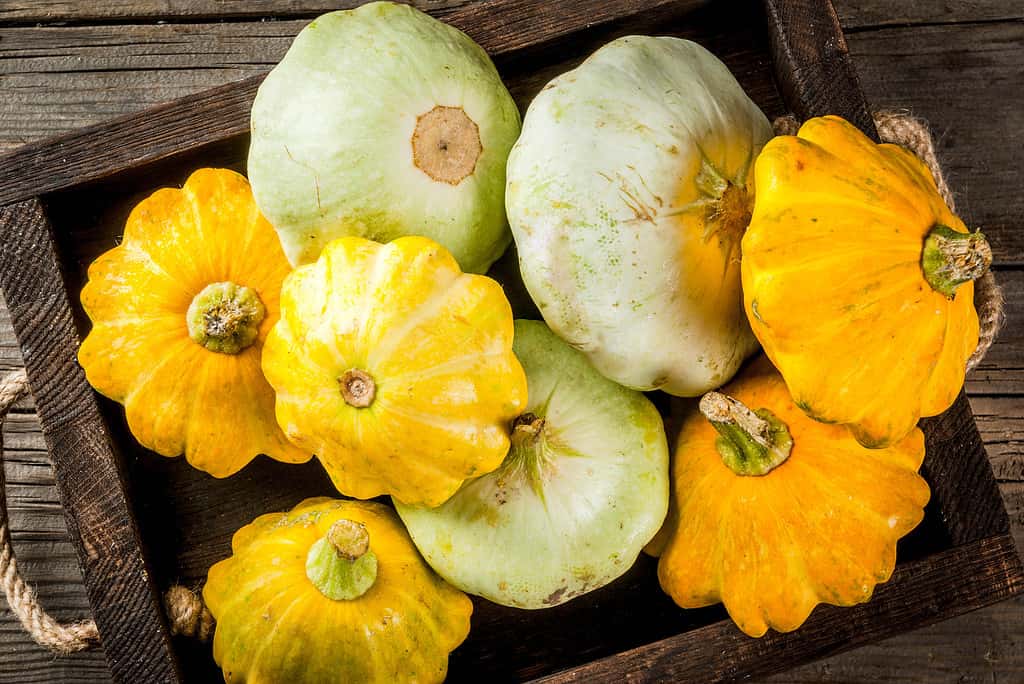
Patty pan squash are delicious sliced into discs and roasted with garlic.
©Rimma_Bondarenko/iStock via Getty Images
There are many wonderful varieties of summer squash and zucchini to grow. Some unique ones include:
- Round Zucchini – This variety is round in shape with a light green color, making it ideal for stuffing or grilling. It’s also very versatile as you can use it in salads or side dishes.
- Cocozelle Zucchini – This heirloom variety has an elongated shape and dark green skin, which adds to its unique appearance
- Zephyr Squash – This hybrid type of summer squash has a bell shape with yellow and green stripes. It’s great for baking, grilling, or sautéing.
- Pattypan Squash – Also known as scallop squash, this variety is shaped like a flying saucer with ridges around the edge. It can be eaten raw or cooked in savory dishes like soups and casseroles.
- Yellow Crookneck – This squash has a curved neck and bright yellow color, making it perfect for grilling or roasting. It’s also delicious when combined with other vegetables in stir-fries or salads.
- Eight Ball Zucchini – This green zucchini looks like a tiny watermelon, but its flavor is similar to that of regular zucchini. It can be eaten raw or cooked in dishes like ratatouille.
| Growing Summer Squash | Summer Squash Recommendations |
|---|---|
| Sun | Full sun with six or more hours of direct sunlight per day |
| Soil | Moist and free draining with a pH of 6.0 to 6.5 |
| When to Plant | After all danger of frost is over, and the soil temperature is 60°F |
| Planting Measurements | Seeds 1 inch deep and 3 inches apart. Rows or mounds 6 feet apart. |
| When to Harvest | 60 days. When fruits are eight inches long or less. |
| Storage | Fridge in a paper bag for ten days. Freezer 3 months. |
| Companion Plants | beans, dill, garlic, marigolds, oregano, peas, nasturtiums, peas, and rosemary. |
The photo featured at the top of this post is © Zhukovskaya Elena/Shutterstock.com
Thank you for reading! Have some feedback for us? Contact the AZ Animals editorial team.






